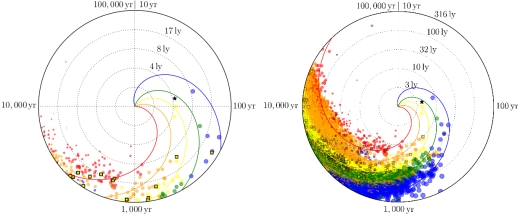Centauri Dreams
Imagining and Planning Interstellar Exploration
Speculations on Habitable Zone Waterworlds
What to make of Fergus Simpson’s new paper on waterworlds, suggesting that most habitable zone planets are of this type? If such worlds are common, we may find that most planets in the habitable zones of their stars are capable of evolving life, but unlikely to host technological civilizations. An explanation for the so-called ‘Fermi Paradox’? Possibly, but there are all kinds of things that could account for our inability to see other civilizations, most of them covered by Stephen Webb in his If the Universe Is Teeming with Aliens … Where Is Everybody? (2nd ed., Springer 2015), which offers 75 solutions to the problem.
Simpson (University of Barcelona) makes his case in the pages of Monthly Notices of the Royal Astronomical Society, arguing that the balance maintained by a planetary surface with large amounts of both land and water is delicate. The author’s Bayesian statistical analysis suggests that most planets are dominated either by water or land, most likely water. Earth may, then, be something of an outlier, with most planets over 90 percent covered in water.
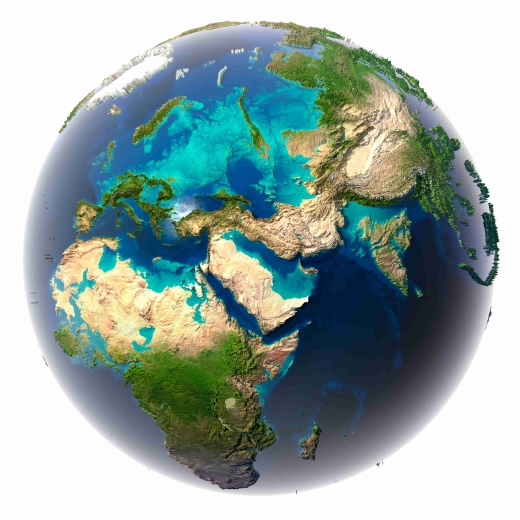
Image: Continents on other habitable worlds may struggle to break above sea level, like much of Europe in this illustration, representing Earth with an estimated 80% ocean coverage. © Antartis / Depositphotos.com.
The unlikelihood of a planet maintaining a balance like the Earth’s gives the paper its direction. Simpson offers a pedagogical example of the Bayesian approach:
…imagine that you look at a kitchen worktop and notice some spilled coffee granules. One of those granules, selected at random, is found to lie within 0.1?mm from the edge of the 600?mm worktop. This proximity could of course be entirely coincidental. But it is much more likely that the bulk of the granules fell on the floor, and what you are seeing is merely the tail end of the distribution.
Is planet Earth at the tail end of the distribution? We don’t have enough exoplanet data to know. But the statistical model here does take note of what we have learned in our explorations of the outer Solar System. Think of Titan, where Stanley Dermott and Carl Sagan predicted in 1995 that instead of a surface covered in extensive ocean, the lack of circularization of the moon’s orbit from oceanic tidal effects pointed to a largely dry surface. We now know that the duo was correct: Titan’s liquid hydrocarbons account for about 1 percent of the total surface area.
Simpson finds this a remarkable call, but he adds that the prediction could have been made even without orbital data on Titan. Let me quote him on this, as it reiterates his method:
On a purely statistical basis, and in the absence of correlations, one expects the division of liquid and solid surface areas to be highly asymmetric. This is because the volume of liquid need not match the capacity of perturbations in the solid. The two quantities often differ by several orders of magnitude. If it is the liquid that dominates, the solid surface becomes completely immersed. Enceladus and Europa offer exemplary cases of this phenomenon. Beneath each of their icy crusts, a single ocean completely envelops a solid core (Kivelson et al. 2000; Waite et al. 2009). If, on the other hand, the liquid’s volume is subdominant, it settles into small disconnected regions, as was found to be the case on the surface of Titan.
To put this in context, we need to consider the delivery of water from icy objects originating beyond the snow line. Here we have to assume a huge variety of outcomes, planets in the habitable zone with a wide variation in the amount of water delivered to the surface. What happens over time? Some water will be found in the mantle, some lost through the upper atmosphere. Planetary topography shapes the distribution of resulting oceans.
The author goes on to consider feedback mechanisms including erosion and soil deposition as well as the deep water cycle by way of placing what happened on Earth in context. Across the galaxy, trillions of dice have been rolled, comments Simpson, and what we would like to know is whether the dice somehow favor a balance between land and water. He thinks not.
Here the anthropic principle weighs in. Does our Earth have the particular balance of water and land we see because planets without this balance — desert worlds or waterworlds — would produce intelligent land-based species at a much lower rate? In other words, if we did not live in a place with this fine-tuned balance, we wouldn’t be observers, something we should keep in mind as we consider the prevalence of worlds like our own. We can also assume that planets with larger habitable areas are more capable of sustaining larger populations. These factors imply to Simpson that the Earth has a greater habitable area than most life-bearing worlds.
We see a planet that could not be otherwise for us to be here, and assume other habitable zone worlds are similar. Our planet, argues the author, is itself close to the waterworld limit, and the water mass fraction among habitable planets could be a good deal higher. From the paper:
…numerical simulations based on delivering water from planetary embryos found a median water mass fractions of approximately 1?per?cent (Raymond et al. 2007), 10 times higher than the terrestrial value. Extremely elevated water compositions have been associated with the inflation of planetary radii (Thomas & Madhusudhan 2016). This scenario, in which the Earth is among the driest habitable planets, could help explain the appearance of a low-mass transition in the mass–radius relation of exoplanets (Rogers 2015; Chen & Kipping 2017).
And if it turns out that the Earth is unusually dry for a habitable zone planet, various mechanisms can explain the result. It is possible that low eccentricities and inclinations of planetary orbits in our Solar System make for less effective water delivery. Perhaps water delivery was affected by migration of the gas giants (Simpson considers the ‘Grand Tack’ model in which Jupiter reversed its migration, but points out that this might also produce a higher rate of water delivery). Or perhaps we have a drier Earth simply because of the stochastic nature of the delivery of water. The trillions of dice throws gave us the numbers we live with and take to be commonplace. We can hardly, then, take the Earth as the norm.
71 percent of Earth is covered by water. In addition to the amount of water delivered (and the mechanisms of that delivery), we have to factor in where it will be stored, how ocean and mantle interact, and how topographical features affect water distribution. Life has been able to emerge and technological civilization take hold because all these factors prevent the planet from becoming a waterworld, a fine balance, says Simpson, that most habitable zone worlds lack.
Simpson’s paper is an intriguing read and one that should provide fodder for science fiction scenarios (I consider that all to the good), but it’s highly speculative given that our models of water delivery in the early Solar System are still works in progress. What we come back to again and again is the need for observation. In the Titan reference Simpson makes early in the paper, it was data that proved the point made by Dermott and Sagan, and data that are required to put such factors as the depth of Earth’s water basins in a cosmic context. So we can keep waterworld theories in mind as we begin studying the actual atmospheric content of exoplanets within coming decades, when new space- and ground-based resources come online.
The paper is Simpson, “Bayesian evidence for the prevalence of waterworlds,” Monthly Notices of the Royal Astronomical Society 468 (3) (2017), 2803-2815 (full text). Thanks to Phil Tynan for an early pointer to this paper.

Further Work on TRAPPIST-1
A closely packed planetary system like the one we’ve found at TRAPPIST-1 offers intriguing SETI possibilities. Here a SETI search for directed radio transmissions aimed at the Earth gives way to an attempt to overhear ongoing activity within another stellar system. For it’s hard to conceive of any civilization developing technological skills that would turn away from the chance to make the comparatively short crossing from one of the TRAPPIST-1 worlds to another.
Our more spread out system is challenging for a species at our level of technological development, but a colony on Mars or an outpost on Titan would surely produce intense radio traffic as it went about daily operations and reported back to Earth. Could TRAPPIST-1 be home to similar activities? The SETI Institute has continued to investigate the prospect, starting with ‘eavesdropping’ observations at 2.84 and 8.2 GHz in early April.
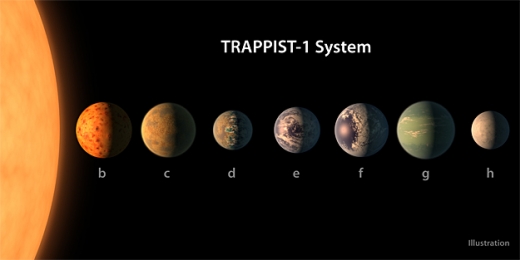
Image: A size comparison of the planets of the TRAPPIST-1 system, lined up in order of increasing distance from their host star. The planetary surfaces are portrayed with an artist’s impression of their potential surface features, including water, ice, and atmospheres. Credit:
NASA/R. Hurt/T. Pyle.
The SETI Institute’s work demands that the Allen Telescope Array be used in what this Institute news release calls ‘camera mode,’ which creates a series of ‘snapshots’ of the field of view every 10 seconds. The method is sensitive to the kind of broadband signals that might be used in spacecraft propulsion (think of the power beaming we’ve discussed often in these pages for getting payloads quickly to Mars and other local targets). The Benfords’ ideas on such a beaming infrastructure are examined in Microwave Beaming: A Fast Sail to Mars, while power beaming as a SETI observable is examined in Seeing Alien Power Beaming and elsewhere.
If a civilization were to be communicating between two worlds in the TRAPPIST-1 system, the time to observe its activities would be when two of the planets align with our view from Earth. It was just such an opportunity, between planets e and f in this system, that the ATA examined on April 6, while another two conjunctions occurred just six days later and were also observed by the ATA. If powerful transmissions were directed from one planet to the other, it might be possible for us to detect the spillover as the beam points toward the destination planet.
Similar observations are planned for May, looking for wideband signals much different from the kind of narrowband beacons the SETI Institute normally hopes to detect. Communications signals would doubtless carry a high data rate, while the broadband signals used in power beaming should likewise be distinctive. The raw data from these observations is being searched by high speed cloud computers, a computationally intensive task that is too expensive for the ATA to perform daily, but one that is assisted by its collaboration with IBM.
Refining Mass Information
While we follow the SETI search here with interest, it’s also worth noting that we’re getting a much tighter set of parameters on the masses of the planets around TRAPPIST-1. These are small worlds, but their proximity means we see substantial transit timing variations in the system. The masses calculated by Michaël Gillon and colleagues in the discovery paper from transit timing variation analysis produced masses for the six inner planets with uncertainties that varied between 30 percent and almost 100 percent.
Tightening up those numbers is the subject of a new paper from Songhu Wang (Yale University) and colleagues, who analyze data from the Kepler spacecraft’s K2 mission to refine the transit timing measurements. Several planets are much better constrained:
Perhaps the most significant conclusion that emerges from our analysis is that the masses of the outer planets, d, e, f, and g all show noticeable decreases in comparison to the values reported by Gillon et al. (2017). For example, the masses of planets e, f, and g (which have equilibrium temperatures of 251 K, 219 K, and 199 K, respectively) have decreased from Me = 0.62 M?, Mf = 0.68 M? and Mg = 1.34 M? to Me = 0.24 M?, Mf = 0.36 M? and Mg = 0.57 M?.
Reading through this paper simply reinforces how useful the planets around TRAPPIST-1 are proving to be — the authors say that they “…arguably constitute the most important exoplanetary system yet discovered.” The reason: We have large transit depths given the small size of the host star, along with extensive transit timing variations, meaning our ability to delve into mass, density and planetary composition here is greatly enhanced. And note this, which is based on the paper’s Figure 5 (not Figure 4, as is mistakenly referenced in the preprint):
…to within the errors of our determinations – the four most distant planets are consistent with pure water compositions, and in any event, are substantially less dense [than] either Mars or Venus.
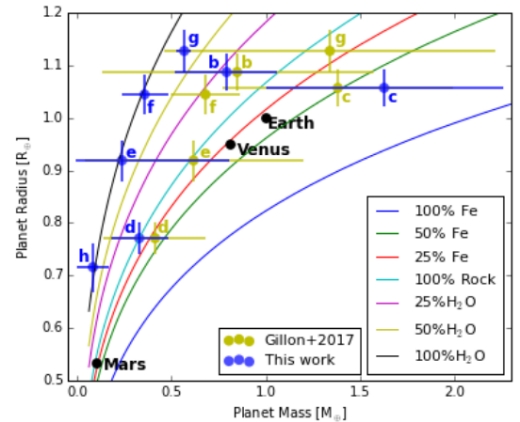
Image: Figure 5 from Songhu Wang et al.. Caption: Planetary masses and radii for Trappist-1 system. Transit timing-inferred masses from the discovery paper (yellow dots) and this work (blue dots) are plotted with 1 ? error bars. Venus, Mars and, Earth are shown as black dots. Theoretical mass-radius relationships for different planetary compositions from Zeng et al. (2016) are plotted as colored curves. Credit: Songhu Wang et al.
The paper is Songhu Wang et al., “Updated Masses for the TRAPPIST-1 Planets,” submitted to the Astrophysical Journal (preprint).

Breakthrough Listen Data Becoming Available
Andrew Siemion (Berkeley SETI Research Center) presented results from the first year of the Breakthrough Listen initiative last Thursday at the Breakthrough Discuss meetings in Palo Alto. The data can be acquired here, with the caveat that file sizes can be gigantic and the data formats demand specialized software. Background information and details are available on this BSRC page. Working with the Parkes instrument in New South Wales as well as the Green Bank telescope in West Virginia and Lick Observatory’s Automated Planet Finder on Mt. Hamilton in California, the project is rapidly amassing petabytes of data.
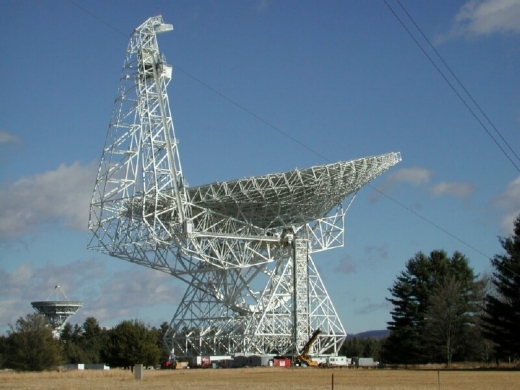
Image: The largest single-dish fully steerable radio telescope began operation in 2000 August in Green Bank, West Virginia, USA. Dedicated as the Robert C. Byrd Green Bank Telescope, the device weighs over 30 times more than the Statue of Liberty, and yet can point anywhere in the sky more precisely than one thousandth of a degree. The main dish is so large that it could house a football game, allowing it to hear even the faint murmurs of quasars located across the universe. Credit: NRAO / NSF.
A paper analyzing 692 stars from the first year of Green Bank data as examined by the Berkeley SETI Research Center science team has been submitted to The Astrophysical Journal covering frequencies from 1.1 to 1.9 GHz. Here we get 400 total hours of observing time comprising 4798 individual observations, with 8 petabytes of raw data acquired. And while the 11 highest ranking events have been getting their share of publicity (you can see the list here, with additional data), the fact is that we have no SETI detections here.
“With the submission of this paper, the first scientific results from Breakthrough Listen are now available for the world to review,” said Dr. Siemion. “Although the search has not yet detected a convincing signal from extraterrestrial intelligence, these are early days. The work that has been completed so far provides a launch pad for deeper and more comprehensive analysis to come.”
Early days indeed, given the magnitude of the challenge, and of course when it comes to doing good science, data rather than preferences or hunches are what we need. Thus SETI is all about the patient accumulation of such data, even as we continue to work the intellectual riddle of possible intelligence elsewhere. We’re making good progress on such key Drake Equation questions as the percentage of stars with planets and the frequency of planets in the habitable zone, but other issues remain completely opaque, including the frequency of life’s emergence and the longevity of a technological civilization.
My own hunch, for what it’s worth, is that it’s the second of these two issues that is the deal breaker.
I hope Breakthrough Listen will prove me wrong. This is a 10-year initiative that will survey the 1,000,000 closest stars to the Earth, while also scanning the center of the Milky Way and the galactic plane as well as examining the 100 galaxies closest to us. We’ll continue to keep a close eye on its proceedings given that the survey covers ten times more of the sky than previous SETI programs and five times more of the radio spectrum at hitherto unrivaled speeds.
The project is also deeply invested in optical SETI, carrying out spectroscopic searches for optical laser transmissions that, according to the project’s founders, can detect a 100 watt laser at the distance of the Alpha Centauri stars. I notice that both Shelley Wright (UCSD) and David Williams (Arizona State) addressed the optical issue at Breakthrough Discuss, with Wright giving the overview of searches in the optical and near-infrared and Williams talking about using telescopes designed for gamma-ray observations to detect engineered optical flashes.
Because I was forced by schedule conflicts to miss Breakthrough Discuss this time around, let me at least post clips from the Breakthrough Initiatives news releases on the conference for a bit more detail. I hope many of you were able to follow the proceedings online. Centauri Dreams reader John Walker reminds me of this significant fact: “Worth noting that in contrast to last year recordings of the proceedings are on offer. For anyone interested in (re)seeing the presentations visit Breakthrough’s Facebook page here: https://m.facebook.com/BreakthroughPrize/video_grid/?ref=page_internal.”
——————————————————————————————————–
BREAKTHROUGH DISCUSS OPENS WITH LIVELY SESSIONS DEDICATED TO
THE SEARCH FOR PLANETS AND LIFE IN OUR COSMIC NEIGHBORHOOD:
CONFERENCE TO CONTINUE ON FRIDAY, APRIL 21, WITH DISCUSSIONS ON FACEBOOK LIVE
The first day of Breakthrough Discuss 2017 explored planets around nearby stars and their potential for life. Charles Alcock opened the conference with the statement that, “The far-fetched ideas of today are the discoveries of tomorrow,” and Peter Michelson emphasized that the last century of scientific investigation has transformed questions about origins from the realm of metaphysics to a place where they can be investigated observationally.
Three of the participants — exoplanet hunters extraordinaire Guillem Anglada-Escudé, Natalie Batalha, and Michaël Gillon — were recognized at the start of the program for making the 2017 TIME 100, TIME magazine’s distinguished list of the world’s most influential people. Anglada- Escudé served as the keynote speaker on Thursday, and Gillon will serve as the keynote speaker on Friday.
Speakers in the first session described the state of the art in observations of planets around nearby stars. Getting pictures of planets is difficult, and most are found using indirect methods. These methods have shown that most stars have planets in short-period orbits, and since most stars in the galaxy are red dwarfs, these provide promising targets when searching for habitable worlds. Many planets around these stars have recently been reported, including Proxima Centauri b, and LHS 1140 b and the TRAPPIST-1 system. Although red dwarfs have high X-ray and UV radiation, and planets around them are more likely to be tidally locked (with one side always in fierce daylight, and the other in cold night), they are long-lived stars, potentially allowing plenty of time for life to arise.
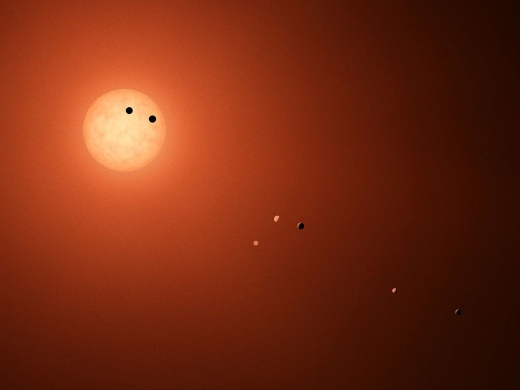
Image: This illustration shows the seven TRAPPIST-1 planets as they might look as viewed from Earth using a fictional, incredibly powerful telescope. The sizes and relative positions are correctly to scale: This is such a tiny planetary system that its sun, TRAPPIST-1, is not much bigger than our planet Jupiter, and all the planets are very close to the size of Earth. Their orbits all fall well within what, in our solar system, would be the orbital distance of our innermost planet, Mercury. With such small orbits, the TRAPPIST-1 planets complete a “year” in a matter of a few Earth days: 1.5 for the innermost planet, TRAPPIST-1b, and 20 for the outermost, TRAPPIST-1h. This particular arrangement of planets with a double-transit reflect an actual configuration of the system during the 21 days of observations made by NASA’s Spitzer Space Telescope in late 2016. The system has been revealed through observations from NASA’s Spitzer Space Telescope and the ground-based TRAPPIST (TRAnsiting Planets and PlanetesImals Small Telescope) telescope, as well as other ground-based observatories. The system was named for the TRAPPIST telescope. Credit: NASA/JPL-Caltech.
The difficulty of imaging planets even around nearby stars is compounded when trying to measure their colors to find indications of life. But, as Mercedes López-Morales described, telescopes that will come online in the mid-2020s will have the capability to detect “biosignatures” in exoplanet atmospheres. By looking for signatures of oxygen and methane, that are naturally destroyed over time if not replenished by such processes as living organisms, perhaps in the next 10 to 15 years we will have found another world where humans could breathe.
Zachary Berta-Thompson noted that 70 years of observations of Pluto saw it simply as a point of light, until the New Horizons probe gave us in-situ measurements of Pluto as a world in its own right. He encouraged the audience to ponder what in-situ observations of habitable zone planets around nearby M-dwarfs might be possible in 70 years’ time.
The second session focused on the search for extraterrestrial intelligence around nearby stars. Andrew Siemion described analysis of the first year of Breakthrough Listen observations of around 700 nearby stars, placing sensitive limits on the presence of engineered emission from these targets, and Danny Price discussed Listen observations of Alpha and Proxima Centauri. Shelley Wright discussed searches in the optical and near-infrared, and David Williams described a novel use of telescopes designed for gamma-ray observations to detect rapid optical flashes. Although no convincing signs of extraterrestrial intelligence have yet been found, the speakers and audience expressed optimism and enthusiasm for what would be possible with the next generation of searches.
The second and final day of the conference, to be held on Friday, April 21, will assess the significance of the newly discovered exoplanets for the long-term Breakthrough Starshot endeavor, a program spearheaded by Yuri Milner to develop a practical interstellar space probe.
As the closest known exoplanet, Proxima b is the current primary target for Starshot, which aims to develop the technology to send gram-scale spacecraft travelling at 20 percent of the speed of light to Alpha Centauri, some 4.367 light-years away. Starshot mission leaders Avi Loeb, Philip Lubin and Zac Manchester are among the distinguished participants at Breakthrough Discuss.
———————————————————————————————————
And here is the Breakthrough Initiatives news release for the second day.
———————————————————————————————————
SECOND ANNUAL BREAKTHROUGH DISCUSS CONFERENCE CLOSES WITH
FULL DAY DEDICATED TO NEWLY DISCOVERED EXOPLANETS AND
THE SEARCH FOR INTELLIGENT LIFE
Two-day conference brought together the world’s leading astronomers, engineers, astrobiologists, and astrophysicists for conversations on recent discoveries and future endeavors
PALO ALTO, CALIF. – April 21, 2017 – Day Two of Breakthrough Discuss opened with Michaël Gillon describing the discovery of TRAPPIST-1, which has seven temperate planets, including three in the habitable zone. The planets were discovered using small ground-based telescopes, and Gillon noted that on initial viewing of the data, there were “so many transits we couldn’t make sense of them.”
Gillon described how observations from several telescopes were used to study the TRAPPIST-1 system, including Kepler to confirm the existence of the planets, and Spitzer to figure out their orbits. Similarly, a suite of telescopes, including Hubble and the James Webb Space Telescope, could be used in the future to search for signs of water and atmospheres on planets that may be detected by the next generation of giant ground-based telescopes.
The morning continued with a panel on the search for extraterrestrial intelligence. The wide-ranging discussion, chaired by the SETI Institute’s Jill Tarter, discussed how studies of unexplained phenomena might lead to new discoveries in astrophysics, or possible evidence of activity by civilizations inhabiting other star systems. From the odd variations in brightness of a star studied by Tabetha Boyajian, to searches by Beatriz Villarroel for stars that might suddenly disappear, panelists described a variety of creative ways to search large, time-domain survey datasets for events of interest. Panelist Lucianne Walkowicz described how modern machine learning algorithms could allow us to look for strange behavior in data without making presuppositions about the kinds of signals extraterrestrials might generate. Jason Wright emphasized that a great deal of work is required to rule out natural astrophysical explanations before resorting to claims of intelligent aliens, and described an upcoming revision to the Rio Scale that is used to assess the credibility of ET claims.
The afternoon sessions focused on the ambitious Breakthrough Starshot plan to send spacecraft to nearby stars. Avi Loeb described how a gram-scale camera attached to a sail propelled by a powerful ground-based laser beam might reach Proxima b during our lifetime, traveling at 20 percent of the speed of light. Feasibility studies will be completed during the next five years, potentially leading to the construction of a kilometer-scale ground station, and the launch of many small, relatively inexpensive spacecraft to explore nearby star systems.
Philip Lubin described how this technology could enable craft to travel from Earth to the Moon in an hour, to Mars in under a day, and to nearby stars in a couple of decades. He talked about the materials science and engineering challenges in designing a sensor package to fit on a thin silicon wafer, and returning data to Earth, but was optimistic that ongoing technological developments would make this “watershed moment in human history” possible in the near future.
René Heller described a “photogravitational assist” technique that might enable a spacecraft traveling at 20 percent of the speed of light to use photons from the Alpha Centauri system as a brake to enter orbit rather than flying rapidly by. The session’s other speakers discussed how a suite of observations, both remote, and in-situ, could detect spectral features of vegetation, light glinting from oceans, and signs of water and oxygen in planetary atmospheres. The conference closed with a panel on science goals and instrumentation for Breakthrough Starshot.
In total, the two-day event featured three sessions of 19 presentations and 15 panelists. The first day, Thursday, April 20, featured a session that focused on recent observations of nearby planets, including Proxima b, and new techniques for observing them. A second session on Thursday examined the possibility of intelligent life in Earth’s cosmic neighborhood, and recent attempts to search for it with Breakthrough Listen.
The conference was broadcast on Facebook Live at www.Facebook.com/BreakthroughPrize. Viewers from around the world were able to join in the conversation and submit questions, which were answered by the panelists in real-time.
Breakthrough Discuss was hosted by Stanford University’s Department of Physics and the Harvard-Smithsonian Center for Astrophysics and sponsored by the Breakthrough Initiatives.
Breakthrough Discuss is an annual academic conference focused on life in the Universe and novel ideas for space exploration.
Breakthrough Initiatives are a suite of scientific and technological programs exploring the big questions around life in the Universe, such as, Are we alone? What are the nearest habitable planets? And can we become an interstellar civilization?
For more information see https://breakthroughinitiatives.org

On Breakthrough Discuss
Although I hadn’t thought I would get a post off today, I do want to get this Breakthrough Initiatives news release out about the upcoming Breakthrough Discuss meeting. Pay particular attention to the online options for participating.
BREAKTHROUGH INITIATIVES TO HOST WORLD-RENOWNED SCIENTISTS AND SCHOLARS IN SUMMIT ON LIFE IN THE UNIVERSE AND SPACE EXPLORATION
Second annual “Breakthrough Discuss” conference held April 20-21 and broadcast on Facebook Live
San Francisco – April 18, 2017 – Breakthrough Initiatives today announced its second annual Breakthrough Discuss scientific conference, which will bring together leading astronomers, engineers, astrobiologists and astrophysicists to advance discussion surrounding recent discoveries of potentially habitable planets in nearby star systems. The conference will take place on Thursday, April 20 and Friday, April 21, at Stanford University.
The two days of discussions will focus on newly discovered Earth-like “exoplanets” in the Alpha Centauri and TRAPPIST-1 planetary systems, and new evidence that these planets could be habitable, as well as their potential as targets for novel methods of space exploration.
Guillem Anglada-Escudé, Queen Mary University of London, and Michaël Gillon, University of Liège, will serve as keynote speakers. Sessions will be chaired by Olivier Guyon, University of Arizona, Jill Tarter, former director of the Center for SETI Research, and Avi Loeb, Harvard University. A full overview of the sessions and panels are listed below.
“In the last 10 months, the world of astronomy has been rocked by discoveries of other planetary systems that look remarkably like our own,” said S. Pete Worden, Executive Director of the Breakthrough Initiatives. “The Breakthrough Discuss conference brings together many of the leading minds to advance the conversation on the potential for life on other worlds and to interrogate the conflicting theories and hypotheses prompted by this new data.”
The two-day event will feature three sessions of 19 presentations and 15 panelists. The first will focus on recent observations of nearby planets, including Proxima b, and new techniques for observing them. The second session will examine the possibility of intelligent life in Earth’s cosmic neighborhood, and recent attempts to search for it with Breakthrough Listen. The third session will assess the significance of the newly-discovered exoplanets for the long-term Breakthrough Starshot endeavor, a program spearheaded by Yuri Milner to develop a practical interstellar space probe.
As the closest known exoplanet, Proxima b is the current primary target for Starshot, which aims to develop the technology to send gram-scale spacecraft travelling at 20 percent the speed of light to Alpha Centauri, some 4.367 light years away. Starshot mission leaders Avi Loeb, Philip Lubin and Zac Manchester will be among the distinguished participants at Breakthrough Discuss.
The conference will be broadcast on Facebook Live at www.Facebook.com/BreakthroughPrize. Viewers are encouraged to join in the conversation and submit questions, which have the opportunity to be answered by the panelists in real-time.
Start times for all sessions will also be posted on the Breakthrough Facebook page. For more information on the program, including a detailed schedule, please visit: breakthroughinitiatives.org/Events.
Breakthrough Discuss is hosted by Stanford University’s Department of Physics and the Harvard-Smithsonian Center for Astrophysics and sponsored by the Breakthrough Initiatives.
Breakthrough Discuss is an annual academic conference focused on life in the Universe and novel ideas for space exploration.
Breakthrough Initiatives are a suite of scientific and technological programs exploring the big questions around life in the Universe, such as, Are we alone? What are the nearest habitable planets? And can we become an interstellar civilization?
For more information see breakthroughinitiatives.org
Breakthrough Discuss
Thursday, April 20 and Friday, April 21
Introduction
Earth has discovered a neighbor.
In August 2016, the exoplanet Proxima b was discovered on our cosmic doorstep. It orbits Proxima Centauri, the nearest star to our Sun, approximately 4.2 light-years (25 trillion miles) away. This was a thrilling discovery: the closest known exoplanet to the Solar System also happens to lie within the habitable zone of its star; and just four months after its launch, Breakthrough Starshot had its first target.
Then, in February 2017, seven exoplanets were identified orbiting a dwarf star named TRAPPIST-1, about 40 light-years (235 trillion miles) from Earth. In cosmic terms, these planets too are just down the street. As evolving observation and propulsion technologies promise to extend our vision and physical presence to interstellar destinations, these potentially habitable or life-bearing worlds are transforming the space of our possibilities for life in our galactic neighborhood: both possibilities for extraterrestrial life, and for the future of humanity.
The discoveries of Proxima b and the seven worlds of the TRAPPIST-1 system will be the overarching theme for this year’s Breakthrough Discuss.
Session One: Observations of Proxima b and Habitable Planets Around Nearby Cool Stars
What can be learned about Proxima b and habitable planets around nearby cool stars by remote sensing from Earth and from near-term space missions? This session will focus on observations and systems, both Earth-based and space-based, for studying the newly discovered Proxima b planet and yet-to-be-identified habitable planets around nearby M-type stars. A particular focus will be on how life might be confirmed, and when this might be feasible.
Session Chair:
* Olivier Guyon, University of Arizona
Session Co-Chairs:
* David Charbonneau, Harvard University
* Lisa Kaltenegger, Cornell University
Session Two: SETI Observations of Proxima b and Nearby Stars
What SETI measurements are possible for Proxima b and nearby stars? This session will review a number of SETI observations already taken of the Proxima Centauri system, and consider new observation possibilities. These include discussion of what “leakage” from a technological civilization might be detected with current instrumentation; what additional observations can and should be made; and ideas for new and untried methods of observation and data-gathering.
Session Chair:
* Jill Tarter, SETI Institute
Session Co-Chairs:
* Tabetha Boyajian, Louisiana State University
* Andrew Siemion, University of California, Berkeley
* Jason Wright, Penn State University
* Shelley Wright, University of California, San Diego
Session Three: Scientific Goals and Instrumentation for a Flyby of the Nearest Stars
Breakthrough Starshot aims to send lightweight probes at a fraction of the speed of light to the nearest stars. What instruments and measurements should be available to this fleet of spacecraft? This session will focus on measurements that could be made by StarChips flying through the Alpha Centauri planetary system, with an emphasis on the search for life on Proxima b. The discussion will include an initial brainstorm on the desired spectral and imaging parameters (resolution and wavelengths), the type of instruments (including novel probes of particles and fields), as well as the optimal flyby distance and trajectory.
Session Chair:
* Avi Loeb, Harvard University
Session Co-Chairs:
* Phil Lubin, University of California, Santa Barbara
* Zac Manchester, Harvard University
* Mason Peck, Cornell
Contacts
For Breakthrough Initiatives
Rubenstein / Kristen Bothwell
212-843-9227 / KBothwell@Rubenstein.com

Mission Concepts: Bound Orbits around Other Stars
Can we use a laser array to get a fast probe to another star? Breakthrough Starshot relies upon the notion, which was first advanced by Robert Forward all the way back in 1962, and subsequently considered by George Marx in 1966, along with hosts of researchers since. With beamed energy we leave the propellant behind, but as we’ve seen in our discussions of deceleration, there remains the problem of slowing down at the target. Breakthrough Starshot assumes a flyby, but the paper we looked at yesterday works out strategies for braking into orbit at the target star. Or more accurately, at the target stars, for multiple systems are assumed.
Let’s dig back into that paper today, but first, let me make a brief administrative comment. The upcoming Breakthrough Discuss meeting in Palo Alto (I covered last year’s sessions) occurs at exactly the wrong time for me — I’m locked into long-standing travel plans elsewhere. While I travel, there will be no Centauri Dreams posts for the rest of this week, though I will try to keep up with comment moderation. Things return to normal next Monday.
Now, as to multiple stars and our target list. René Heller, Michael Hippke and Pierre Kervella use multiple stars as ‘photon bumpers,’ depending upon steep deceleration at one or more in order to slow the craft and deflect it on to a final target. Alpha Centauri is the obvious case in point, for using these methods we can consider a probe that brakes into orbit around Proxima b after decelerating encounters with Centauri A and B. The new paper revises a January paper from Heller and Hippke by offering trajectories that provide for faster cruise times.
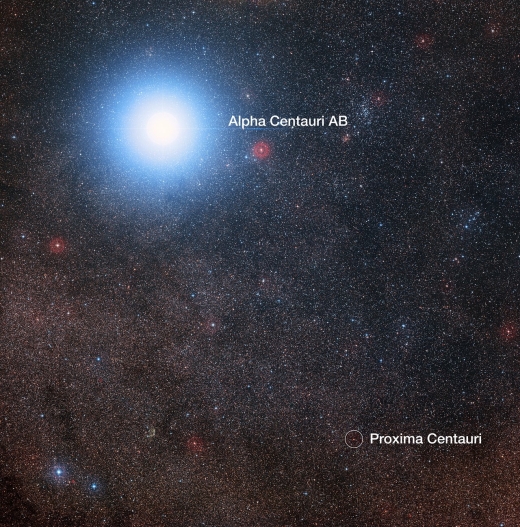
Image: This image of the sky around the binary Alpha Centauri AB also shows the much fainter red dwarf star, Proxima Centauri, the closest star to the Solar System. The picture was created from images forming part of the Digitized Sky Survey 2. Credit: Digitized Sky Survey 2. Acknowledgement: Davide De Martin/Mahdi Zamani.
Interstellar Destinations
As we saw yesterday, the authors believe they can cut the travel time to Centauri A and B from 95 to 75 years (with an additional 46 years necessary for the crossing to Proxima Centauri). All this depends upon maximizing the arrival speed at the first star while producing enough deceleration through photon braking to make the needed speed and course adjustments. And if this can be done at Alpha Centauri, it can be done with other nearby systems, but we would experience much longer travel times with single stars like Tau Ceti or Epsilon Eridani.
Fortunately, multiple star systems abound, offering interesting possibilities. Having optimized the trajectories for Proxima Centauri, the authors consider Sirius A, which is actually about twice the distance from the Sun as Alpha Centauri. The star is bright enough (24.2 solar luminosities) that maximum insertion speed into the Sirius system can be high, some 12.5% of the speed of light. We get a much faster cruise speed coupled with much more dramatic deceleration, and the travel time of 69 years is actually shorter than our Proxima mission.
Sirius is itself a binary, with a white dwarf, Sirius B, that would be useful to study. The paper’s Table 2 is worth reproducing here, as it broadens the range of targets still further.
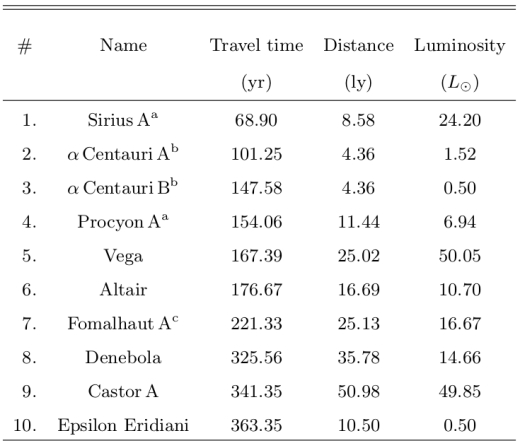
Image: The paper’s Table 2. Caption: An interstellar travel catalog to use photogravitational assists for a full stop. Credit: Heller, Hippke and Kervella.
Notice that Epsilon Eridani is 10.5 light years away, while Sirius A is 8.58 light years distant, but the journey to Epsilon Eridani is a whopping 363 years compared to the 68.9 to Sirius. Here again we’re relying on the innate brightness of Sirius to allow the fast insertion speed that will accommodate maximum cruise velocity plus deceleration and trajectory change at destination — we don’t have this at Epsilon Eridani. But that also presupposes that we have the ability to launch a craft at a blistering 12.5 percent of c. Breakthrough Starshot talks about 20% of c through the use of an Earth-based laser array. For their part, Heller, Hippke and Kervella think a hybrid accelerative boost might be the best approach:
A graphene-class sail could have a maximum ejection speed of about 11,500 km s ?1 from the solar system if it was possible to bring it as close as five solar radii to the Sun and then initiate a photogravitational launch (Heller & Hippke 2017). This is much less than the maximum injection speed of 17,050 km s ?1 that can be absorbed by successive photogravitational assists at ? Cen A to C. If sunlight were to be used to push a lightsail away from the solar system, then its propulsion would need to be supported by a second energy source, e.g. a ground-based laser array, to fully exploit the potential of photogravitational deceleration upon arrival. A combination with sunlight might in fact reduce the huge energy demands of a ground-based laser system.
Lessening the requirements for the array is all to the good considering the challenge of building it and powering it up. Of course, the hybrid approach assumes huge advances in sail materials, though the authors believe that current progress with graphene will make a workable sail for these purposes feasible within the next few decades. However we reach the necessary speeds, we can look at the prospect of even faster speeds with the assistance of other stars.
The Sirius Afterburner
Which gets us back to Sirius, where the authors consider what they call the ‘Sirius afterburner,’ in which the star becomes the instrument for achieving higher speeds than we can achieve with Earth-based technologies. The authors’ numerical simulations show that minimizing deceleration during approach while maximizing the acceleration after the flyby can increase the velocity of the lightsail up to 27,000 km s-1. That’s a boost of 9 percent of the speed of light. Sirius, then, with its proximity to the Sun and its brightness, becomes what the paper calls “the most natural choice for an interstellar photogravitational hub for humanity.”
Taking that broad view of a possible future is what the paper’s next figure is all about.
Image: Travel times (as hour angles) versus stellar distance to the solar system (along the radial coordinate) for stars in the solar neighborhood. Symbols refer to numerical trajectory simulations to individual targets, lines refer to the logarithmic spiral derived in Equation (4). The spirals are parameterized using M2V (red), K5V (orange), G2V (yellow), F3V (green), and A0V (blue) template stars from Pecaut & Mamajek (2013). Square symbols represent stars with known exoplanets. The black star symbol represents ? Cen. Left: All 117 stars within 21 ly around the Sun. Right: 22,178 stars out to 316 ly around the Sun. Credit: Heller, Hippke & Kervella.
A photogravitational hub like this can yield an interesting target list indeed. We have a total of 328 known exoplanet host stars within 316 light years, and many stars of astrophysical interest in themselves. Among these, the authors suggest such destinations as TV Crateris, which is a quadruple system of young T Tauri stars about 150 light years away. 36 Ophiuchi is a triple system of K stars some 19.5 light years out. Also intriguing: Fomalhaut, 25 light years away and another triple, with exoplanet Fomalhaut b and protoplanetary disks around Fomalhaut A (Alpha Piscis Austrini) and C (LP 876-10).
We would like to reach any number of single star targets as well, especially nearby red dwarfs of the sort that we will soon be analyzing for biosignatures, but achieving a bound orbit around such a star would involve extremely long travel times. A flyby more like the basic Breakthrough Starshot concept seems to make more sense for these because unlike Proxima Centauri, they have no nearby bright stars to slow the incoming craft and alter its trajectory.
The paper is sanguine about the prospects for developing the needed technologies for the missions examined herein. Components currently under development include:
…procedures for the large-scale production of graphene sheets, nanowires with the necessary electronic properties consisting of single carbon atom layers, gram-scale cameras and lasers (for communication between the sail and Earth), or sub-gram-scale computer chips required to perform on-board processing etc. We thus expect that a concerted effort of electronic, nano-scale, and space industries and research consortia could permit the construction and launch of ultra-light photon sails capable of interstellar travels and photogravitational assists, e.g. to Proxima b, within the next few decades.
Making any of these missions happen, though, demands the highest degree of aiming accuracy, which we lack even for the Alpha Centauri stars (and bear in mind that Gaia will not observe Centauri A or B). To pull off a successful ‘bank shot’ in the Centauri system, we will have to nail the proper motion and binary orbital motion of the AB binary. Right now our data are simply not sufficient: The authors note that we lack the current capability to achieve orbital injection and swing-by to Proxima, something that will have to be remedied through highly precise astrometry.
The paper is Heller, Hippke and Kervella, “Optimized trajectories to the nearest stars using lightweight high-velocity photon sails” (preprint).

Proxima Mission: Fine-Tuning the Photogravitational Assist
Deceleration has always been problematic in projected schemes for interstellar travel. A flyby of a star at a substantial percentage of lightspeed yields a fraction of the data that would be obtainable by a probe slowed into orbit in the target system. But how to slow down? In particular, how do you slow down when your method of propulsion is beamed energy?
The ideas have flowed over the years, ranging from Philip Norem’s ‘thrustless turning’ — using interactions between the spacecraft and the interstellar magnetic field — to Robert Forward’s ‘staged’ sail, in which the sail separates into separate components, with beamed laser light from Earth bouncing off one to the other to slow the payload. Norem’s notion, though, hugely lengthened trip times while taking the spacecraft far beyond the target before turning it back, while staged sails require a pointing accuracy in a laser array that is hard to imagine.
Many other options have been advanced, including braking against a stellar wind with a magsail, but it was a recent paper from René Heller (Max Planck Institute for Solar System Research, Göttingen) and German colleague Michael Hippke that got my attention at the beginning of February (see By ‘Photogravitational Assists’ to Proxima b). Heller and Hippke are now joined by Pierre Kervella (CNRS/Universidad de Chile) in a reworking of the original idea with a major twist, a far more effective means of slowing and turning the craft which, in turn, produces much faster travel times because it allows a higher speed upon arrival.
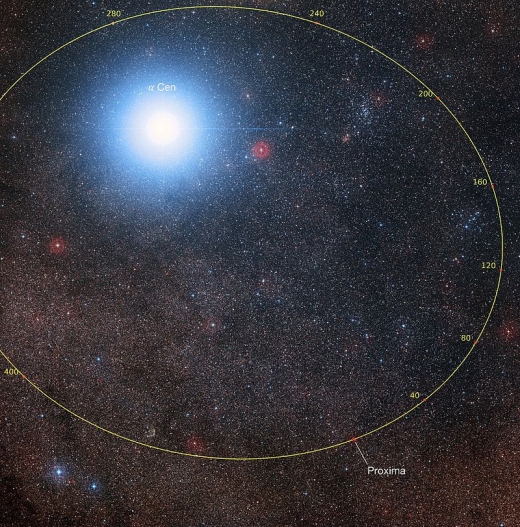
Image: Orbital plot of Proxima Centauri showing its position with respect to Alpha Centauri over the coming millennia (graduations are in thousands of years). The large number of background stars is due to the fact that Proxima Cen is located very close to the plane of the Milky Way. Credit: P. Kervella (CNRS/U. of Chile/Observatoire de Paris/LESIA), ESO/Digitized Sky Survey 2, D. De Martin/M. Zamani –https://www.eso.org/public/images/ann16089a/
Photogravitational Assists and Lightsails
The original Heller/Hippke paper fit nicely with the Breakthrough Starshot idea, in that what the latter was proposing was to accelerate small beamed sails up to 20 percent of the speed of light for a flyby of the Proxima Centauri system and its interesting planet Proxima b. Hippke and Heller advocated using the G-class Centauri A and K-class Centauri B as ‘photon bumpers,’ with a much larger lightsail than Breakthrough Starshot envisioned being slowed and having its trajectory altered by photon pressure and gravity, with a final deflection to Proxima Centauri itself, which the craft would approach at a speed slow enough for photon braking into orbit.
The new paper finds a more efficient way of using a star as a photon bumper, one that increases the deceleration at Centauri A and B and thus allows the sail to approach these stars faster. The savings are substantial: Using a modified photogravitational assist as suggested here, we cut the travel time from 95 years to 75 years. You can see that to use these methods, a single star is not optimum. We look instead for multiple systems in which we can use two or more stars to pull off this interstellar bank shot. Intriguingly, it turns out that the Alpha Centauri system may not actually be the closest — in time — for such a mission, but more on that later.
The spacecraft that Heller, Hippke and Kervella have in mind is made of an ultralight material like graphene, which would be coated with “a highly reflective broadband coating made of sub-wavelength metamaterials.” For a Centauri mission, the craft would be brought up to cruise velocity by a close solar pass rather than accelerated through a ground-based laser array, the method being investigated by Breakthrough Starshot. The lightsail would be accelerated to a cruise velocity of 4.6 percent of c. It would use the assist maneuver upon arrival at Centauri A and B and brake into Proxima to achieve a bound orbit around Proxima b.
When using the photon pressure of a star and its gravitational pull to both decelerate and deflect an incoming sail, the key is to find the maximum possible injection speed at the first destination star. Doing that at Alpha Centauri A would allow the necessary flyby and course adjustment at Centauri B, followed by deflection to Proxima. Finding that injection speed has to be factored against reaching the required deflection angle between inbound and outbound trajectories.
The new work introduces follow-up studies to the Heller/Hippke paper that tweak the simulations with a revised concept, one that favors stellar photon pressure over gravity in enhancing the deflection. The result: “we demonstrate that such a photogravitational assist is more effective when the star is used as a bumper (i.e. the sail passes “in front of” the star) rather than as a catapult (i.e. the sail passes “behind”or “around” the star).”
From the paper (note that v?,max, as discussed below, is the maximum speed of arrival for a successful deceleration and deflection within the Centauri system) :
From a geometry perspective, it is more efficient to let the sail approach the star on the same side (e.g. on the left, see Figure 1) as the desired deflection (i.e. to the left). We then find that, using the same optimization strategy for deceleration as Heller & Hippke (2017), a maximum total deceleration of v?, max = 17, 050 km s ?1 can be reached at ? = 19° , where 8, 800 km s ?1 and 8, 400 km s ?1 can be lost at A and B, respectively.
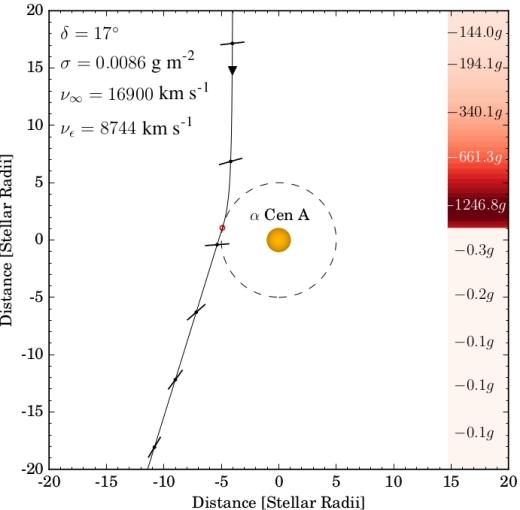
Image: Figure 1 from the paper. Caption: Trajectory of a lightsail performing a photogravitational assist at ? Cen A (orange circle). The bar along the trajectory visualizes the instantaneous orientation of the sail determined to maximize the deceleration. The values in the legend denote the deflection angle, the mass-to-surface ratio, the inbound velocity, and the outbound velocity of the sail. The color bar at the right shows the g-forces acting on the sail along the trajectory, where g = 9.81 m s ?2 is the acceleration on the Earth’s surface. Credit: Heller, Hippke and Kervella.
The revised work thus changes the original Proxima b mission. Assuming the intent is to brake into the Proxima system for close examination of the planet, then the sail is better oriented so as to avoid maximum deceleration during its encounter with Centauri B. This allows the cruise to Proxima to continue with a residual speed of 1,270 km s-1, which is the maximum speed that can be used to fully brake into the Proxima system. As you can see, the authors must juggle the fastest possible cruise times with the maximum injection speeds.
So we have learned that when the photogravitational assist is made at the same side of the star as the desired deflection, as opposed to a gravitational swing behind the star (the method of the original paper), the injection speed at Centauri A (and thus cruise speed enroute) is increased substantially. The authors’ calculations involving a graphene lightsail show an injection speed (v?, max) of 17,050 km s-1 for the new method (this works out to 5.7% c, as opposed to the previous 13,800 km s-1, which is 4.6% of c). We get an increase in speed of 24 percent, while we reduce travel times from Earth to Centauri A and B from 95 years to 75 years.
Adding in the travel time to Proxima Centauri after the photogravitational assists at Centauri A and B, we get a total travel time from Earth to a bound orbit in the Proxima Centauri system of 121 years, with the final 1,280 km s-1 absorbed through photon braking at Proxima itself. 46 years, in other words, is needed to go from Centauri AB to Proxima. What a shame we can’t launch such a mission this year, for the alignment in the Centauri system is such that a mission arriving at Centauri AB in 2092 would allow minimum travel times and maximum injection speeds. In 2092 the deflection required by the sail for the AB photogravitational assist is smallest.
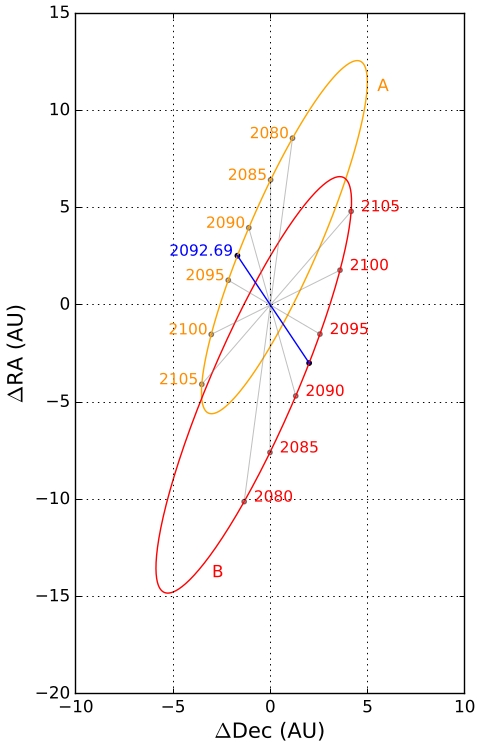
Image: Figure 2 from the paper. Orbital trajectories of ? Cen A (orange) and B (red) in their barycentric coordinate system as seen from Earth using differential RA and Dec coordinates. The AB vector at the time of their closest apparent encounter in 2092.69 (8 September 2092) is marked in blue. Credit: Heller, Hippke and Kervella.
It should be clear from all this that to calculate the actual value of the maximum injection speed at Centauri A and B, we need to calculate the deflection angle required by the sail to make the necessary trajectory adjustments. This will be the case in any nearby system to which we hope to apply these methods. And here we find the interesting result that there are systems which could be closer in terms of travel time than Alpha Centauri itself. Tomorrow we’ll return to this paper to look at the possibilities for photogravitational assists to bound orbits in other systems.
The paper is Heller, Hippke and Kervella, “Optimized trajectories to the nearest stars using lightweight high-velocity photon sails” (preprint).

